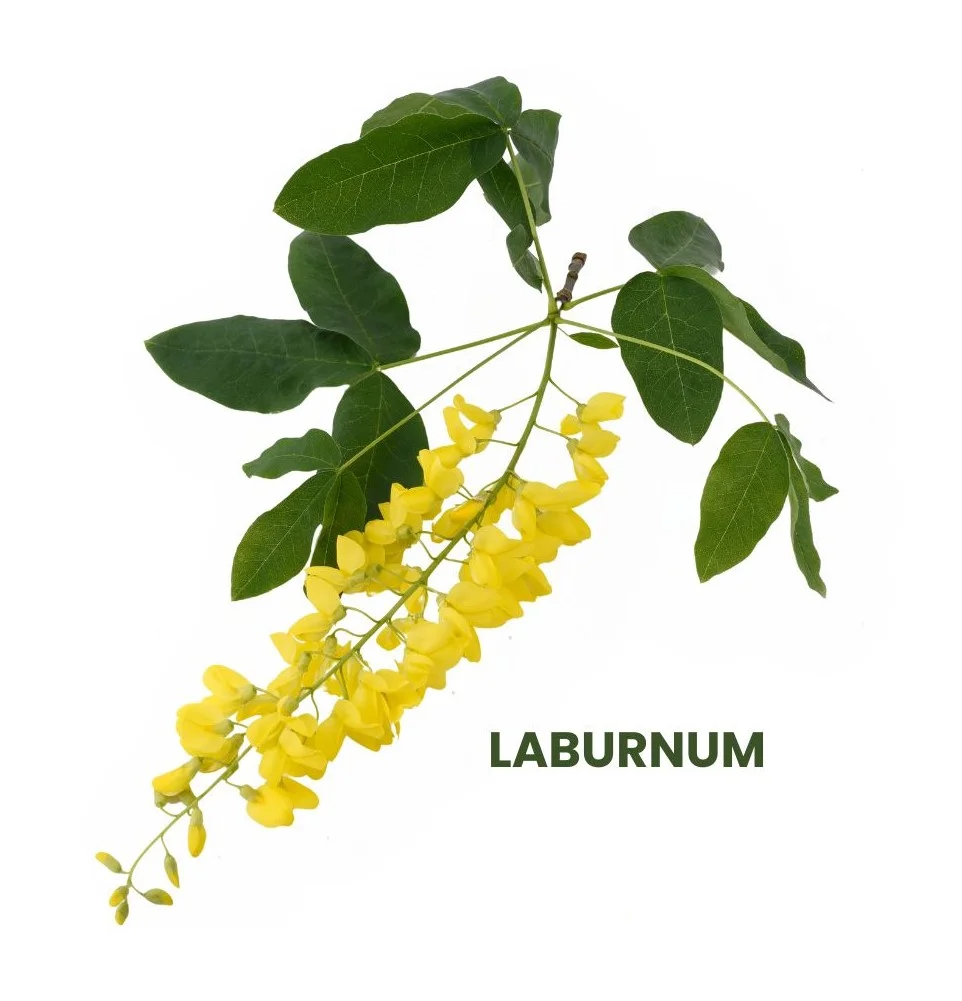Cytisus laburnum, commonly known as Laburnum, is a shrub known for its poisonous nature.
All parts of the plant contain toxic compounds that can cause inflammation of the stomach and intestines, leading to symptoms such as vomiting, diarrhoea, headache, paleness of the face, and cold skin.
In homoeopathy, it is utilised to address various conditions, including cerebrospinal meningitis, convulsions, and anaesthetic effects.

Table of Contents
ToggleSOURCE INFORMATION
Laburnum, commonly known as Golden Chain or Laburnum, is a genus of flowering plants belonging to the Fabaceae family.
The most notable species within this genus is Laburnum anagyroides, which is native to parts of Europe.
Laburnum plants are known for their beautiful clusters of yellow flowers, which hang in pendulous chains, hence the name “Golden Chain.”
Scientific Classification
- Kingdom: Plantae
- Order: Fabales
- Family: Fabaceae
- Genus: Laburnum
- Species: Laburnum anagyroides
Origin
- Laburnum anagyroides is native to Europe, particularly found in regions such as the Alps, the Pyrenees, and the Balkans.
- It is commonly cultivated in gardens and parks for its ornamental value, adding beauty to landscapes with its vibrant yellow flowers.
Historical and Interesting Facts
- Laburnum has a long history of cultivation in Europe, dating back to the 16th century.
- It was highly regarded in garden designs during the Victorian era and remains popular in modern landscaping.
- Despite its aesthetic appeal, all parts of the Laburnum plant, including the flowers, seeds, and pods, contain toxic compounds called cytisine and alkaloids.
- Ingestion of these parts can lead to poisoning, causing symptoms such as inflammation of the stomach and intestines, vomiting, diarrhoea, headache, and even convulsions.
- Due to its toxicity, Laburnum has been used historically as a deterrent against pests and grazing animals.
Homoeopathic preparation
- In traditional herbal medicine, Laburnum has limited use due to its poisonous nature.
- However, some homoeopathic practitioners may utilise highly diluted preparations of Laburnum for specific therapeutic purposes.
DRUG PATHOGENESIS
- Laburnum produces inflammation of the stomach and intestines, leading to symptoms such as vomiting and diarrhoea.
- It also induces widespread anaesthesia and can cause convulsions.
- Other effects include cerebrospinal meningitis, prostration, stiffness of the neck, and tearing pains from the nape into the occiput.
KEY CHARACTERISTICS
- Poisonous nature affecting the gastrointestinal tract and nervous system.
- Induces symptoms of inflammation, convulsions, anaesthesia, and prostration.
- Associated with cerebrospinal meningitis and stiffness of the neck.
PARTICULAR ORGAN SYMPTOMS
HEAD
- Stupefaction and indifference, similar to Phosphoric acid.
- Unequally dilated pupils, giddiness, and twitching of facial muscles, resembling symptoms of Agaricus.
- Hydrocephalus, indicating abnormal accumulation of cerebrospinal fluid in the brain.
- Constant vertigo and intense sleepiness.
STOMACH
- Excessive thirst and constant nausea, vomiting.
- Burning pain in the epigastrium.
RECTUM AND GENITALS
- Tenesmus and erections.
- Grass-green urine.
EXTREMITIES
- Numbness and pain in the hands.
- Difficulty in moving them.
MODALITIES
- Symptoms may be worsened by ingestion or contact with the plant’s toxic parts. Nausea, vomiting, and gastrointestinal discomfort may be prominent.
WHAT ARE MODALITIES IN HOMOEOPATHY?
RELATIONSHIP WITH OTHER DRUGS
- Comparable to Nux vomica and Gelsemium in terms of symptomatology.
- Shares similarities with Cystine, which produces motor paralysis resembling that of curare and may lead to death through respiratory paralysis.
DOSE
- Laburnum is typically administered in the third potency, following homoeopathic principles.
- Dosage should be determined by a qualified homoeopathic practitioner based on individual symptomatology.
Frequently Asked Questions
Is Laburnum poisonous?
- Yes, Laburnum is highly toxic, and all parts of the plant contain poisonous alkaloids.
What are the common symptoms of Laburnum poisoning?
- Symptoms include inflammation of the stomach and intestines, vomiting, diarrhoea, headache, paleness of the face, and cold skin.
How is Laburnum used in homoeopathy?
- In homoeopathy, Laburnum is utilised to address conditions such as cerebrospinal meningitis, convulsions, and anaesthesia-like effects.
What precautions should be taken when handling Laburnum?
- It is essential to handle Laburnum with care, avoiding ingestion or contact with the plant’s toxic parts to prevent poisoning.
Meaning of Difficult Words
- Prostration: Extreme physical or mental weakness.
- Anaesthesia: Loss of sensation or feeling, often induced for medical procedures.
- Cerebrospinal Meningitis: Inflammation of the membranes surrounding the brain and spinal cord.
- Convulsions: Involuntary, violent muscle contractions and relaxations.
- Alkaloids: Naturally occurring chemical compounds, often with pharmacological effects, found in plants.
